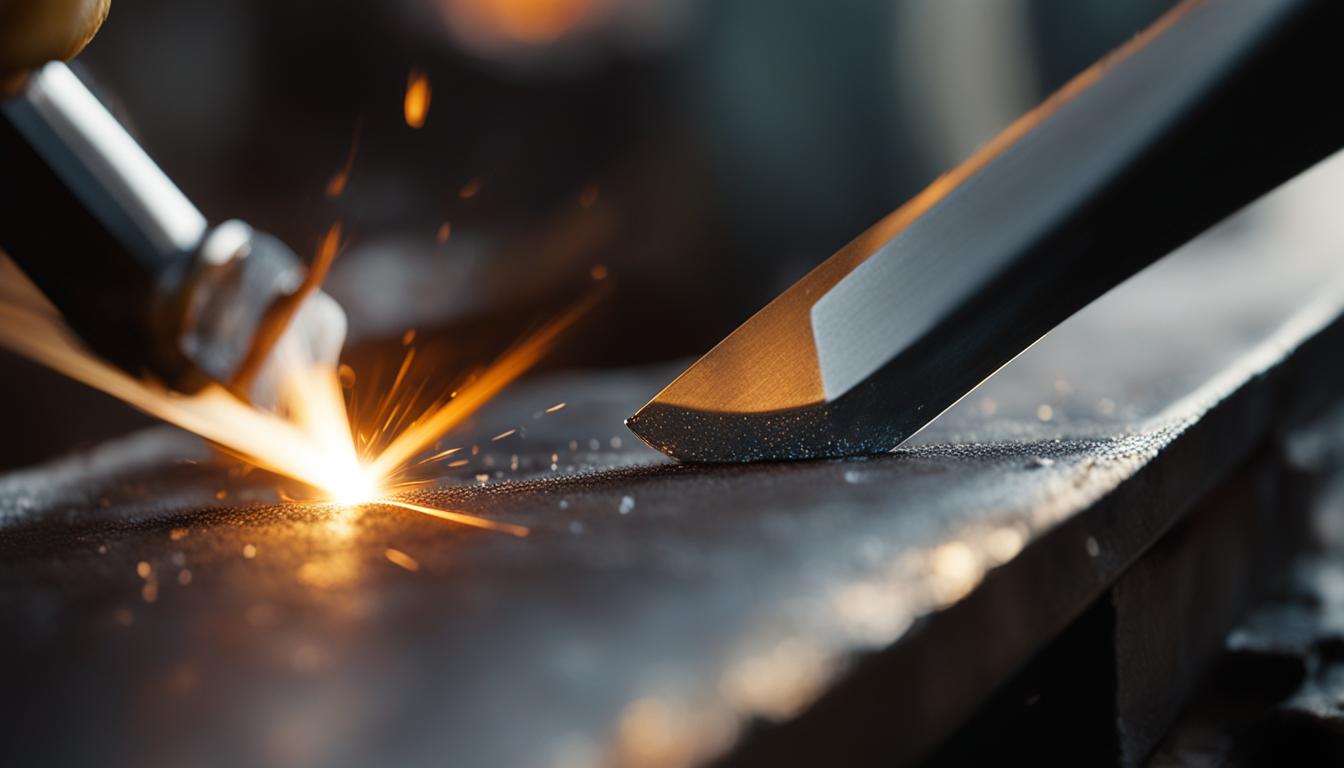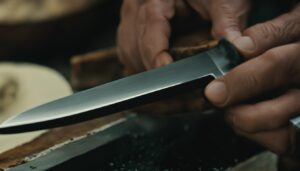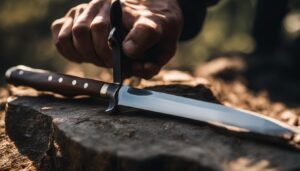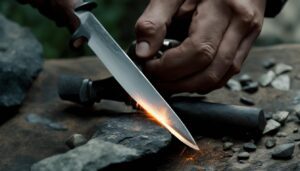Knife sharpening is a skill that requires practice and precision. As a professional knifemaker, I have learned the essential hacks for sharpening hunting knives to razor-sharp perfection. In this article, I will share valuable tips and tricks that will elevate your sharpening game and ensure your hunting knives are always at their best.
Key Takeaways:
- Hunting knife sharpening requires understanding the distinctions between hunting knives and other types of knives.
- Using high carbon ball bearing steel, such as 52100, is recommended for hunting knives.
- Sharpening involves setting the edge on a rough side of a sharpening stone and finishing it on a smooth side.
- Stropping is the final step in the sharpening process and involves using a leather strop to refine the knife’s edge.
- Assess the sharpness of the knife using the paper test or a BESS tester.
Understanding Stropping: The Final Step in Knife Sharpening
Stropping is a crucial technique that completes the knife sharpening process, ensuring a polished and refined edge. Unlike sharpening, which involves removing material to create a new edge, stropping uses a leather strop and a micro-abrasive compound to refine and align the edge of the blade. The stropping process involves drawing the knife backward across the strop, alternating from side to side. This motion allows the abrasive particles embedded in the leather to remove any remaining burr or imperfections, resulting in a razor-sharp edge.
While leather is the most commonly used material for stropping, other options like denim or canvas can also be effective. The key is to select a material that contains microscopic abrasive particles to hone the knife’s edge. It is important to maintain a similar angle to the one used during sharpening for optimal results. This can be achieved by holding the knife at a consistent angle and moving it across the strop in a controlled manner.
To achieve the best stropping results, it is recommended to follow the entire shape of the blade, gradually decreasing the pressure applied as you progress. This helps to create a finer and more even edge along the entire length of the blade. Additionally, to restore the effectiveness of a dry leather strop, applying petroleum jelly and compound can rejuvenate its surface. It’s also worth noting that different types of strops, such as cardboard, can be used as they contain tiny abrasive particles that aid in the stropping process.
Benefits of Stropping:
- Refines and aligns the knife’s edge for optimal sharpness
- Removes any remaining burrs or imperfections
- Creates a polished finish for an aesthetically pleasing blade
- Helps maintain the edge between sharpening sessions
By incorporating stropping into your knife sharpening routine, you can elevate the sharpness and performance of your blades. It is an essential skill that every knife enthusiast should master to ensure their knives are always in top condition.
Expert Tips and Tricks for Knife Sharpening with the Pro PA
When it comes to knife sharpening, the Pro PA (Professional Precision Adjust) is a valuable tool that can take your sharpening skills to the next level. As an experienced sharpener, I have gathered a few tips and tricks that can help you achieve exceptional results using the Pro PA.
Ensure Ample Lighting
Good lighting is essential when sharpening knives, as it allows you to observe the bevels, check for consistency, and create fresh new bevels. Make sure you have sufficient lighting in your workspace to accurately assess the knife’s edge and make precise adjustments during the sharpening process.
Use the Right Tools
In addition to the Pro PA, there are a few other tools that can enhance your sharpening experience. A Torx bit driver is handy for disassembling the knife, making it easier to access and sharpen different parts of the blade. Lubrication is crucial when using the Pro PA, so having oil on hand to lubricate the moving parts ensures smooth and efficient sharpening. It’s also a good idea to have some Loctite to secure any screws or fasteners after assembling the knife.
Cleanliness is Key
Keeping your work area clean is crucial for achieving optimal results. A brush with boar’s hair bristles is ideal for removing debris and particles that can affect the sharpening process. Regularly clean your workspace to prevent any buildup that could compromise the quality of your knife sharpening.
Document Sharpening Angles
Documenting the sharpening angles for each knife can provide valuable reference material for future sharpening sessions. This documentation allows you to maintain consistency and achieve the same results every time. You can create a simple spreadsheet or use a notebook to record the sharpening angles for different knives, making it easy to replicate the process when needed.
With these tips and tricks, you can maximize the performance of your Pro PA and sharpen your knives to perfection. Remember to work in a well-lit environment, use the appropriate tools, maintain cleanliness, and document your sharpening angles for consistent results. By utilizing the Pro PA effectively, you’ll be able to achieve razor-sharp edges and elevate your knife sharpening skills.
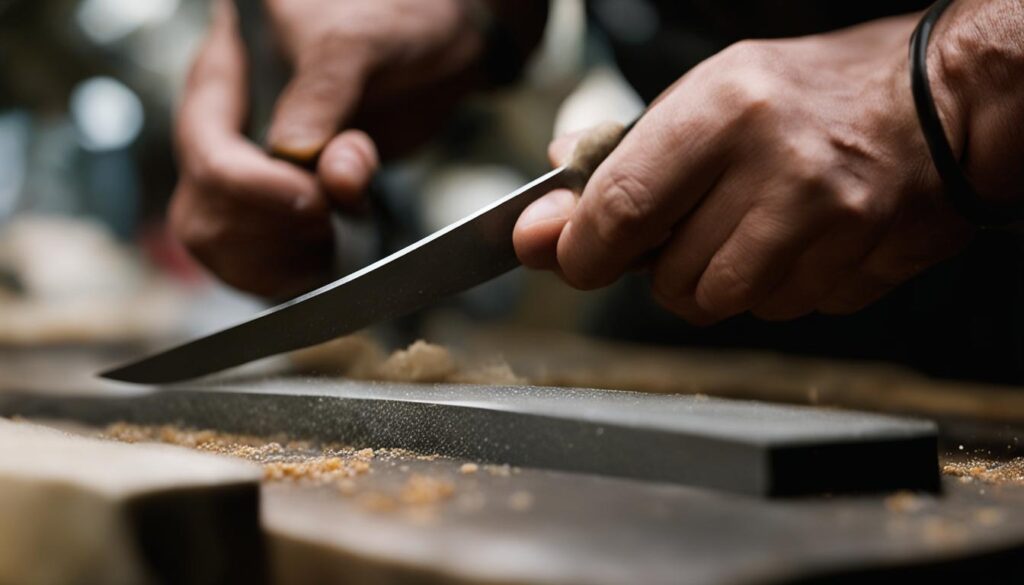
Assessing Knife Sharpness: Paper Test and BESS Tester
After sharpening a knife, it is crucial to assess its sharpness to ensure that it is honed to perfection. There are various methods for testing the sharpness of a blade, including the popular paper test and the BESS tester.
1. The Paper Test
The paper test is a simple yet effective way to evaluate the sharpness of a knife. To perform this test, take a sheet of paper and hold it vertically. With a gentle slicing motion, attempt to cut through the paper. A sharp knife should glide effortlessly through the paper with minimal force or pressure, leaving a clean and smooth cut. If the blade skips or tears the paper instead of slicing through it cleanly, it may indicate that the knife is not sharpened well or that there is a burr on the blade that needs to be removed.
2. The BESS Tester
The BESS (Basic Edge Sharpness Scale) tester is a more scientific method of measuring blade sharpness. It measures the downward force required to cut a standard piece of filament. The scale on the BESS tester provides a numeric value that indicates the sharpness of the knife. A lower number on the BESS scale indicates a sharper knife, while a higher number suggests a duller blade. This tool is commonly used in the knife industry to ensure consistent sharpness during production and sharpening processes.
Both the paper test and the BESS tester are valuable tools for assessing knife sharpness. They allow you to determine the quality of your sharpening job and make any necessary adjustments to achieve the desired level of sharpness. By regularly testing the sharpness of your knives, you can ensure that they are always ready for any cutting task.
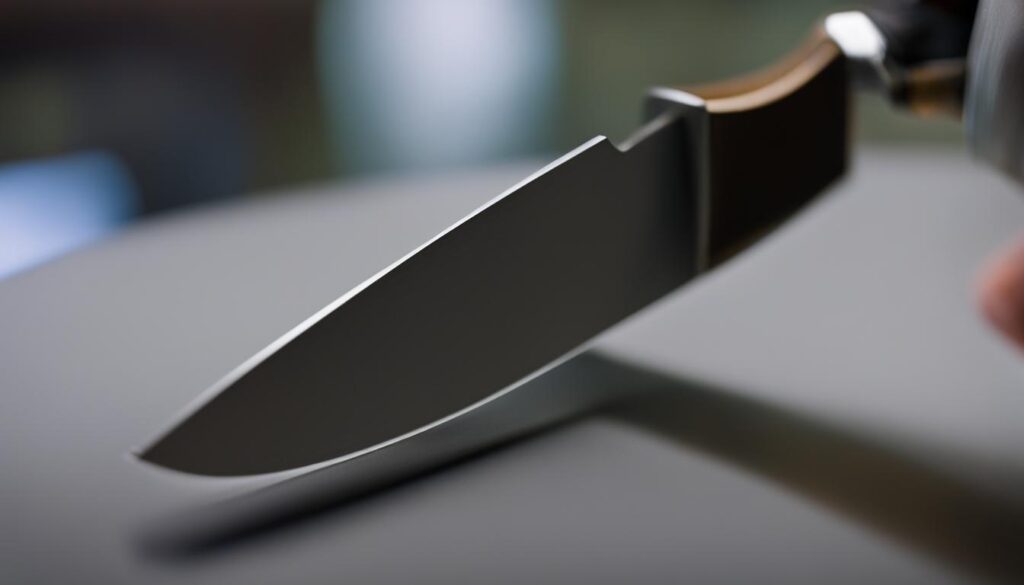

| Method | Advantages | Disadvantages |
|---|---|---|
| Paper Test | – Simple and easy to perform – Provides a quick assessment of sharpness – Requires minimal equipment |
– Subjective results – Does not provide quantitative measurements |
| BESS Tester | – Provides objective and quantitative measurements – Allows for precise comparison between different blades – Used in the knife industry for consistent sharpness standards |
– Requires specialized equipment – May be less accessible for casual users |
Honing Perfection: Tips for a Consistent Sharpening Experience
Consistency is the key to achieving exceptional results when sharpening knives. By following these tips and techniques, you can ensure that each knife is honed to perfection and that you consistently achieve razor-sharp edges.
Creating a Routine
One of the most effective ways to maintain consistency in knife sharpening is by establishing a routine. This includes using the same tools, following a step-by-step process, and adhering to a specific angle for each knife. By doing so, you can develop muscle memory and ensure that you achieve the same results every time.
Using the Right Tools
Having the appropriate tools for sharpening is essential for consistency. Whether you prefer using a whetstone, a Pro PA, or a leather strop, make sure that you are using tools that suit your technique and the type of knife you are sharpening. Investing in high-quality tools will not only improve your sharpening experience but also contribute to more consistent results.
Paying Attention to Details
When sharpening knives, it’s crucial to pay attention to the smallest details. This includes maintaining consistent pressure, maintaining a steady angle, and checking for any signs of burrs or imperfections on the blade. By being meticulous in your approach, you can ensure that each knife is sharpened evenly and precisely.
| Consistency Techniques | Benefits |
|---|---|
| Establishing a routine | Develops muscle memory for consistent sharpening |
| Using the right tools | Enhances sharpening experience and yields more consistent results |
| Paying attention to details | Ensures each knife is sharpened evenly and precisely |
By incorporating these techniques into your knife sharpening routine, you can achieve consistent and exceptional results every time. Remember to follow a routine, choose the right tools, and pay attention to even the smallest details. With practice and dedication, you can elevate your sharpening skills and enjoy consistently sharp knives for all your hunting needs.
Conclusion
In conclusion, mastering the art of knife sharpening is an essential skill for any hunting enthusiast. By following the hacks and techniques outlined in this article, you can achieve razor-sharp edges on your hunting knives.
Stropping, as the final step in the sharpening process, plays a crucial role in refining the edge to perfection. Using a leather strop and maintaining a consistent angle, you can remove any remaining burrs and achieve a finely honed blade.
Expert tips and tricks, such as utilizing the Pro PA tool and assessing sharpness through tests like the paper test and BESS tester, further enhance the sharpening experience. Consistency throughout the process, from lighting and workspace cleanliness to documenting sharpening angles, ensures consistent results for all your knives.
With dedication and attention to detail, you can become proficient in knife sharpening and enjoy the benefits of sharper, more efficient hunting knives. So, sharpen your blades with confidence and elevate your hunting experience. Happy sharpening!
FAQ
What is the ideal angle for sharpening a hunting knife?
The ideal angle for sharpening a hunting knife is 20 degrees.
What type of steel is recommended for hunting knives?
High carbon ball bearing steel, such as 52100, is recommended for hunting knives.
What is the process of sharpening a knife?
The process involves setting the edge on the rough side of a sharpening stone and finishing it on the smooth side.
What grit stones are recommended for sharpening a knife?
A 220 grit stone is recommended for setting the edge, while a 600 grit stone is recommended for finishing it.
Why is stropping important in knife sharpening?
Stropping is important as it removes burrs and helps achieve an even edge along the entire length of the blade.
Can materials other than leather be used for stropping?
Yes, materials like denim or canvas can also be used for stropping.
How should a knife be stropped?
A knife should be drawn backward across the strop, alternating from side to side to push any remaining burr back and forth along the blade.
What tools can enhance the knife sharpening process?
Tools like the Pro PA, Torx bit driver, oil for lubrication, and Loctite for securing screws can enhance the knife sharpening process.
How can consistency be maintained in knife sharpening?
Consistency can be maintained by having good lighting, keeping a clean work area, and documenting sharpening angles for each knife.
How can knife sharpness be assessed?
Knife sharpness can be assessed through tests like the paper test and the use of a BESS tester.
What is the importance of consistency in sharpening knives?
Consistency is important to achieve consistent results and maintain the sharpness of the blade.
